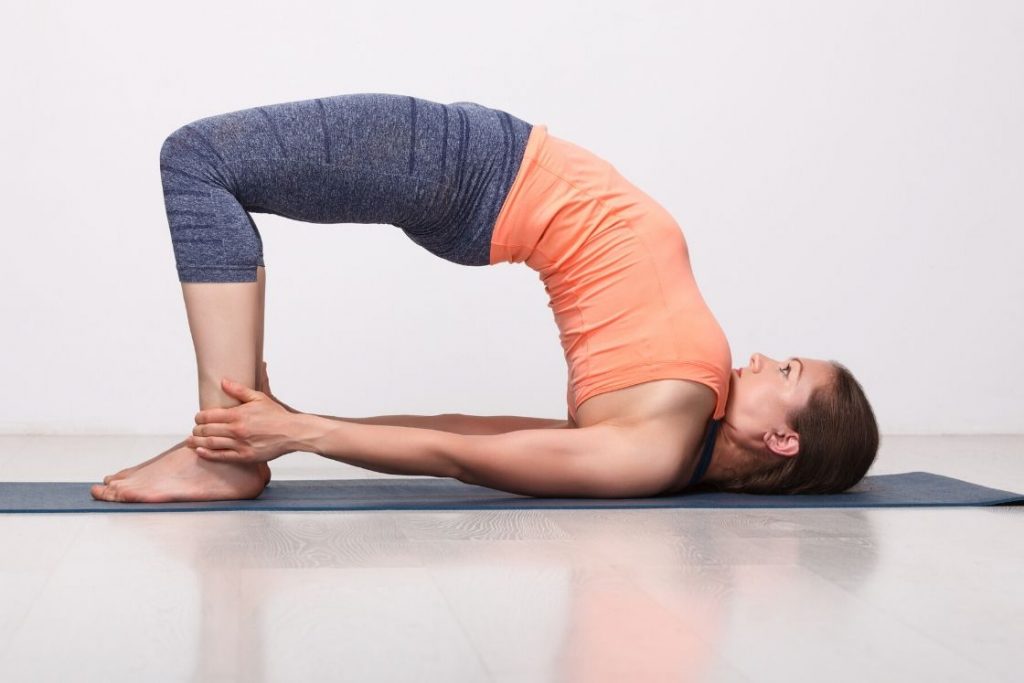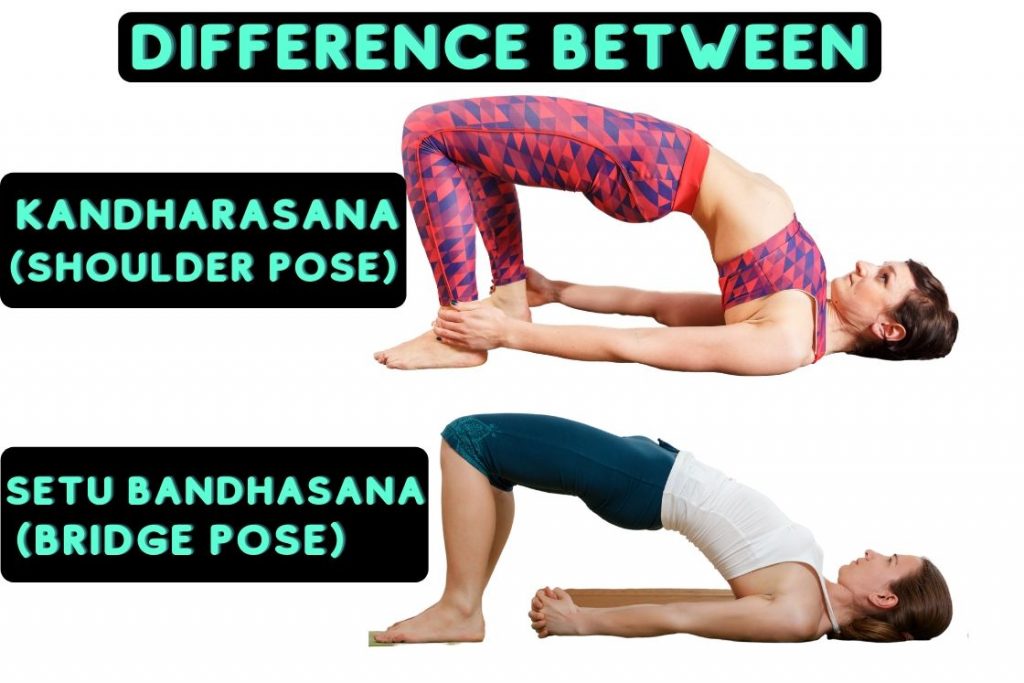
Kandharasana is a back-bending series asana. People having breathing problems or stiffness in the chest get surely benefit from this asana. It strengthens and broadens the thorax to open your breathing passages.
Practicing Kandharasana involves head touching the ground. It eradicates ego (head being seat of ‘I’ ness) and encourages empathy and kindness in the practitioner.
Meaning
In Sanskrit, ‘Kandha’ means ‘shoulder’. Indeed, in Kandharasana, the whole weight of the body in the backbend position comes over the shoulder. It makes shoulder primary engaged muscle in this pose. Hence, Kandharasana is called the ‘Shoulder pose’.
The body appearance in Kandharasana looks very similar to Setu bandhasana (bridge pose), but these 2 poses have some significant difference:

- In Kandharasana, we stretch hands forth to grab the ankles that let our weight transfer to shoulders. In contrast to this, hands are kept simply on the ground in Setu bandhasana.
- What makes Kandharasana the shoulder pose is that whole body weight lifting through shoulders, whereas in Setu bandhasana, some weight is also lifted through our hands.
The regular practice of Kandharasana can help in enhancing the lower and upper body posture along with refined movements of concerning regions. Along with it, the elevated reproductive organs in the backbend position make this asana induce pressure around the reproductive organ. Hence, Kandharasana a good pose for reproductive problems.
Kandharasana Practice Guide
Following are the point to rely on for the safe practice of this asana.
Precautions and Contradictions
- Practitioners with the condition of ulcer (peptic or duodenal) should avoid doing this asana. It might worsen the sores concerning linings.
- It should also not be practiced in shoulder dislocation or any kind of pain and injury in that area.
- Pregnant women refrain from practicing Kandharasana as involves stretching of the entire abdominal region along with the lower back.
- Any type of injury in the spine, knee, and elbows are not advisable to keep up with this asana.
- Practioner with abdominal surgery and hernia refrain from performing this asana. This could cause severe problems for the concerning area.
Preparatory Pose
- Wheel Pose (chakrasana)
- Bow Pose (Dhanurasana)
- Cobra Pose (Bhujangasana)
Kandharasana Steps

- Lie down straight on your mat in Savasana. Stretch your legs straight and arms along the side of the body.
- Now, bend the knees and place your feet on the ground. From here, extends your arms to grab ankles firmly.
- Bring your feet near to the buttocks. Now, lift your hips off the ground after inhale and arch back. Try to form c-curve in the back, and extend it as well.
- The weight of the body should be on your feet, arms, shoulder, neck, and head.
- Now you’re in the final position of Kandharasana. Maintain here for a few calm breaths.
Release
Maintain the posture for 20 to 30 seconds. However, one can also increase the time depending on the ease of holding the posture.
Slowly reduce the curve from the back with the help of quadriceps muscles. Bring down your shoulder, back of the torso, lower back, and finally hips.
Straightened the knee and let your body relax in Savasana (corpse pose).
Beginners Tips
- Beginners lack flexibility in their back so avoid going in the pose with jerking. Try to go slow and steady.
- Ignorance invites injury. So, avoid practicing without any theoretical and practical knowledge. It could cause a serious injury.
- Do not distribute inappropriate weight on any sensitive parts, for example, neck and head. Always try to get into the pose slowly and return alike as well.
Props and Modification
- One can use a strap or rope to reach to the ankles in case of tight knees and stiffened shoulder.
- Those who are new to this asana practice can begin by bringing a normal arch in the back.
- In case of a weak back, support your back by placing elevated bolsters below your back arch.
- In case of stiffened back of the neck, one can practice neck rotation prior to the Kandharasana practice.
Follow up Poses
- Seated Forward Bend (paschimottanasana)
- Any forward bending posture.
Kandharasana Benefits
- Practicing kandharasana tones up the lower body internal organs. Normally backbends improve the functioning of the gall bladder, liver, pancreas, kidneys, intestines, and digestive system.
- In the case of females, it helps in the toning of the reproductive organs. Overcomes menstrual-related disorders. Moreover, it eradicates the problems of females who have the tendency to miscarriage.
- A study has shown, Kandharasana along with other back-bending pose is beneficial for the back extension of female Students [efn_note] Effects of selected Asana’s on back extension of female students http://www.journalofsports.com/pdf/2018/vol3issue2/PartH/3-2-64-447.pdf [/efn_note]. It increases the strength, power, and endurance of the lower back, upper back, and erector spine.
- Kandharasana lays weight on shoulders and by grabbing the ankles, it enhances their range of movement. Also, it makes the shoulders wide. Wide shoulders can help a person in daily tasks of lifting heavy objects and reduce the chance of getting injured during exercise [efn_note] Benefits from Strong Shoulders https://www.dummies.com/health/exercise/weights/benefits-from-strong-shoulders/ [/efn_note].
- The regular practice of Kandharasana carves an aesthetically strong core. This creates a productive approach to daily life physical activities.
- Bending of the neck in this asana results in the stimulation of the thyroid gland, which secretes thyroxin hormone and helps in Hypothyroidism.
- It cures various spinal postural problems that arise due to bad posture, for example, Scoliosis, Kyphosis, and Lordosis. one can achieve postural freedom by the regular practice of this asana.
- Arching of the spine lays pressure on the abdominal region which results in massaging effects over the digestive system. It refines the function to secrete digestive juices and enzymes in an optimum proportion. Hence, aids in digestion.
- Reaching the ankles broadened the thoracic volume. It enhances respiratory capacities. Therefore, improve the lung’s ability to respiration. However, it is also helpful in asthma.
- According to one of the studies [efn_note] Cardiopulmonary and Metabolic Effects of Yoga in Healthy Volunteers https://www.ncbi.nlm.nih.gov/pmc/articles/PMC5793005/ [/efn_note], the Regular practice of Kandarasana along with other yoga practices helps in the regulation of heart rate, blood pressure, and BMI of the practitioner.




